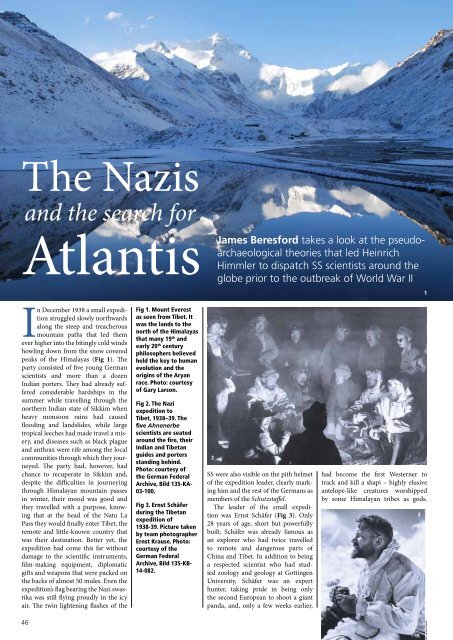Cult of beauty - Minerva
Cult of beauty - Minerva
Cult of beauty - Minerva
You also want an ePaper? Increase the reach of your titles
YUMPU automatically turns print PDFs into web optimized ePapers that Google loves.
The Nazis<br />
and the search for<br />
Atlantis<br />
In December 1938 a small expedition<br />
struggled slowly northwards<br />
along the steep and treacherous<br />
mountain paths that led them<br />
ever higher into the bitingly cold winds<br />
howling down from the snow covered<br />
peaks <strong>of</strong> the Himalayas (Fig 1). The<br />
party consisted <strong>of</strong> five young German<br />
scientists and more than a dozen<br />
Indian porters. They had already suffered<br />
considerable hardships in the<br />
summer while travelling through the<br />
northern Indian state <strong>of</strong> Sikkim when<br />
heavy monsoon rains had caused<br />
flooding and landslides, while large<br />
tropical leeches had made travel a misery,<br />
and diseases such as black plague<br />
and anthrax were rife among the local<br />
communities through which they journeyed.<br />
The party had, however, had<br />
chance to recuperate in Sikkim and,<br />
despite the difficulties in journeying<br />
through Himalayan mountain passes<br />
in winter, their mood was good and<br />
they travelled with a purpose, knowing<br />
that at the head <strong>of</strong> the Natu La<br />
Pass they would finally enter Tibet, the<br />
remote and little-known country that<br />
was their destination. Better yet, the<br />
expedition had come this far without<br />
damage to the scientific instruments,<br />
film-making equipment, diplomatic<br />
gifts and weapons that were packed on<br />
the backs <strong>of</strong> almost 50 mules. Even the<br />
expedition’s flag bearing the Nazi swastika<br />
was still flying proudly in the icy<br />
air. The twin lightening flashes <strong>of</strong> the<br />
46<br />
Fig 1. Mount Everest<br />
as seen from Tibet. It<br />
was the lands to the<br />
north <strong>of</strong> the Himalayas<br />
that many 19 th and<br />
early 20 th century<br />
philosophers believed<br />
held the key to human<br />
evolution and the<br />
origins <strong>of</strong> the Aryan<br />
race. Photo: courtesy<br />
<strong>of</strong> Gary Larson.<br />
Fig 2. The Nazi<br />
expedition to<br />
Tibet, 1938–39. The<br />
five Ahnenerbe<br />
scientists are seated<br />
around the fire, their<br />
Indian and Tibetan<br />
guides and porters<br />
standing behind.<br />
Photo: courtesy <strong>of</strong><br />
the German Federal<br />
Archive, Bild 135-KA-<br />
03-100.<br />
Fig 3. Ernst Schäfer<br />
during the Tibetan<br />
expedition <strong>of</strong><br />
1938-39. Picture taken<br />
by team photographer<br />
Ernst Krause. Photo:<br />
courtesy <strong>of</strong> the<br />
German Federal<br />
Archive, Bild 135-KB-<br />
14-082.<br />
2<br />
James Beresford takes a look at the pseudoarchaeological<br />
theories that led Heinrich<br />
Himmler to dispatch SS scientists around the<br />
globe prior to the outbreak <strong>of</strong> World War II<br />
SS were also visible on the pith helmet<br />
<strong>of</strong> the expedition leader, clearly marking<br />
him and the rest <strong>of</strong> the Germans as<br />
members <strong>of</strong> the Schutzstaffel.<br />
The leader <strong>of</strong> the small expedition<br />
was Ernst Schäfer (Fig 3). Only<br />
28 years <strong>of</strong> age, short but powerfully<br />
built, Schäfer was already famous as<br />
an explorer who had twice travelled<br />
to remote and dangerous parts <strong>of</strong><br />
China and Tibet. In addition to being<br />
a respected scientist who had studied<br />
zoology and geology at Gottingen<br />
University, Schäfer was an expert<br />
hunter, taking pride in being only<br />
the second European to shoot a giant<br />
panda, and, only a few weeks earlier,<br />
had become the first Westerner to<br />
track and kill a shapi – highly elusive<br />
antelope-like creatures worshipped<br />
by some Himalayan tribes as gods.<br />
3<br />
1

















